Rome, the Eternal City, is a breathtaking mosaic of history, art, and vibrant culture. However, its beauty often comes with a side of bustling tourists crowding the most famous spots. This article is your secret map to veering off the beaten path, discovering 10 hidden gems in Rome where tranquility reigns and authentic charms whisper softly.
As someone who has navigated the narrow cobbled streets and dove deep into Rome’s heart, I’ve unearthed corners of the city that remain relatively untouched by the relentless pulse of tourism. These are places where you can savor the quiet majesty of Rome, feel the texture of its ancient story, and enjoy the city as the locals do.
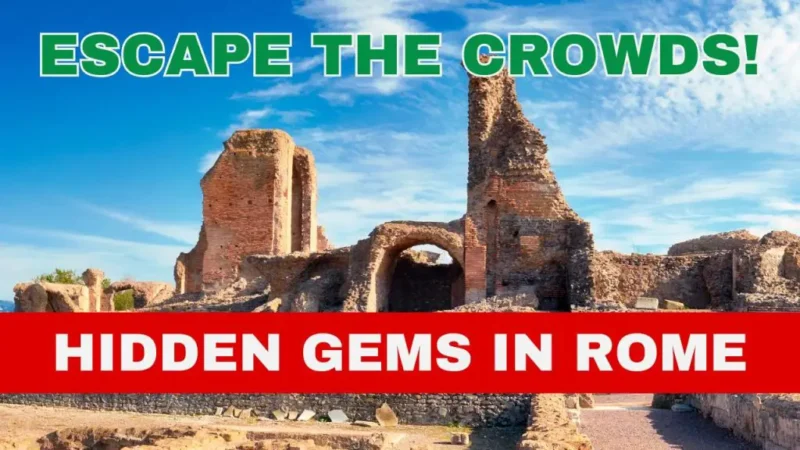
From serene gardens that elude the guidebooks to tucked-away ruins and churches that offer a genuine taste of Rome’s past, each site promises a unique, unspoiled experience. In fact, I think you can truly feel the majesty of Rome in these attractions that would be a huge tourist magnet anywhere else where they didn’t have to compete against the Colosseum, Roman Forum, Pantheon and more.
Embarking on the journey to find these treasures, I discovered not just the physical beauty of the locations, but the stories and histories that they carry. This guide aims to take you by the hand, away from the chaos, and into Rome’s peaceful embrace, where every nook has a tale to tell. Let’s explore together the lesser-known wonders that await in this iconic city, and perhaps, find a little piece of Rome to call our own.
10 Hidden Gems In Rome To Escape The Crazy Crowds
1. Quartiere Coppedè
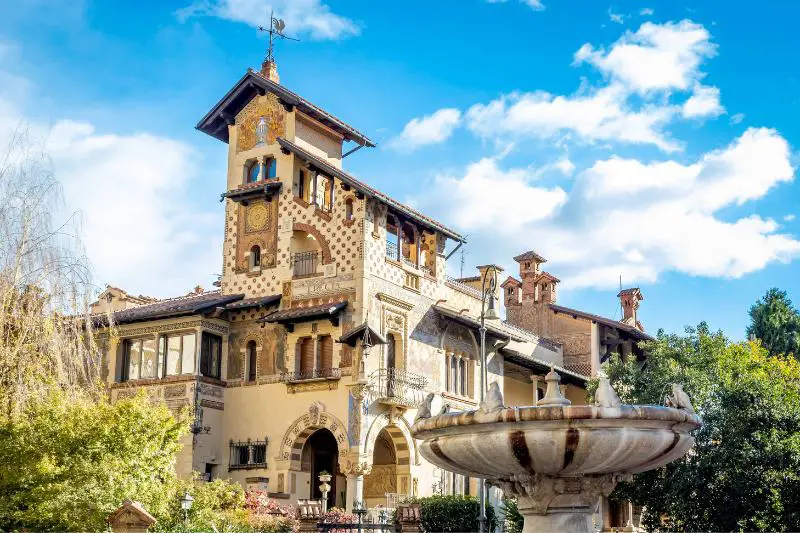
Quartiere Coppedè is not just a neighborhood in Rome; it’s a fantastical escape into an architectural wonderland, where every building tells a story. Designed by Gino Coppedè in the early 20th century, this area merges a variety of styles including Art Nouveau, Gothic, Baroque, and even ancient Greek and Roman influences.
The whimsy of Coppedè is best exemplified by the elaborate Frog Fountain, which sits at the heart of the district, serving as both a centerpiece and a welcome to visitors. Walking through Quartiere Coppedè, one can’t help but feel transported into a fairy tale, with detailed facades, curious sculptures, and intricate ironwork.
The area remains relatively untouched by the heavy foot traffic of Rome’s more famous sites, offering a serene exploration of one of the city’s most creatively ambitious projects. It’s a must-visit for architecture enthusiasts and those looking to uncover Rome’s hidden artistic treasures.
2. Centrale Montemartini
The Centrale Montemartini museum is a testament to Rome’s ability to blend the ancient with the modern in profoundly innovative ways. Located in a converted early 20th-century power station, the museum juxtaposes classical Roman sculptures against the industrial backdrop of the former electric plant.
This unlikely pairing creates a striking contrast and highlights the timeless beauty of the art pieces in a new light. The museum houses a significant collection from the Capitoline Museums, including impressive statues, mosaics, and frescoes, allowing visitors to appreciate these classical works in a quieter setting.
Exploring the Centrale Montemartini offers a unique, meditative experience, where the marriage of industrial architecture and ancient art speaks to the eternal city’s layers of history and its continual reinvention.
3. Giardino degli Aranci (Orange Garden)
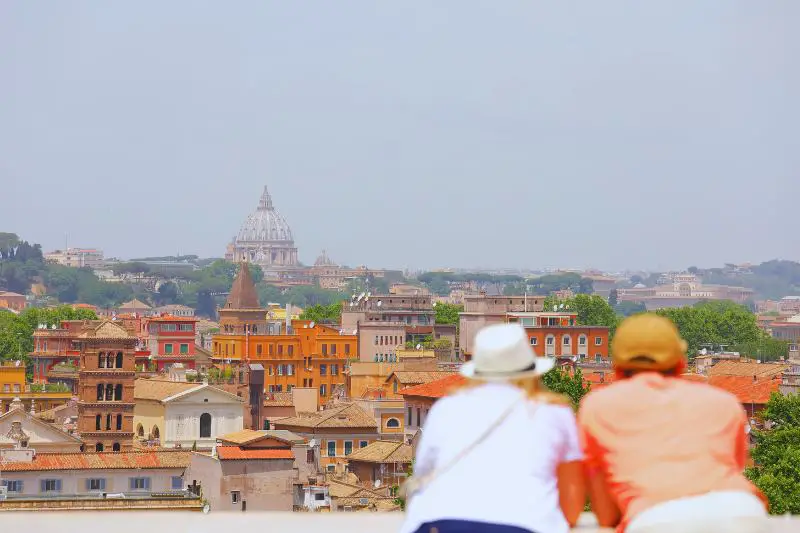
Tucked away on the Aventine Hill, the Giardino degli Aranci (Orange Garden) is one of Rome’s most enchanting spots, offering a stunning view over the city, including a vista that reaches as far as St. Peter’s Basilica. Named for its abundant bitter orange trees, the garden is an emblem of peace and tranquility, a haven for those looking to escape the bustle of the city.
The garden’s design follows the principles of Renaissance symmetry and incorporates a terrace that offers one of the most romantic views of Rome. It’s the perfect spot for a serene picnic, a contemplative walk, or simply to watch the sunset bathe the Eternal City in golden light. For those seeking both beauty and solitude in Rome, the Giardino degli Aranci is an indispensable stop.
4. Via Appia Antica
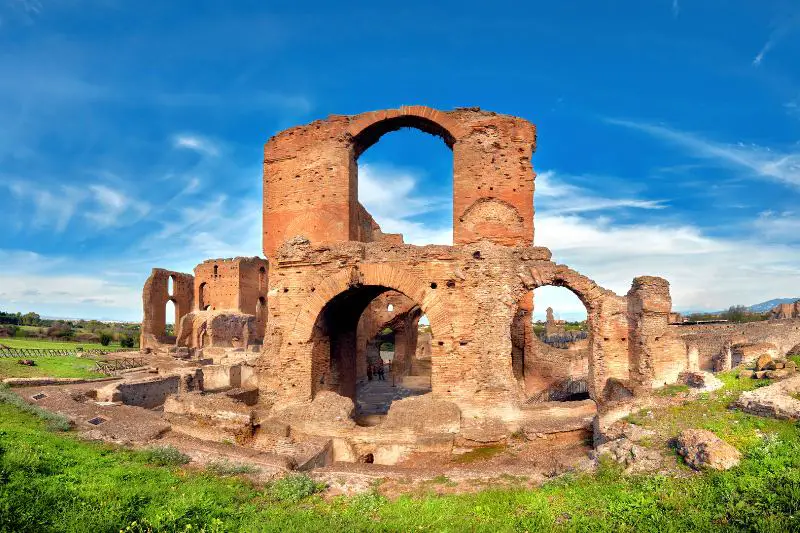
The Appian Way (Via Appia Antica) is more than just a road; it’s a journey back in time. As one of the earliest and strategically most important Roman roads, it is lined with ruins of ancient tombs, monuments, and catacombs, offering a tangible connection to the past.
Walking or biking along its cobbled path, surrounded by greenery, you can almost imagine the legions, traders, and travelers who once traversed this route. Today, it serves as a peaceful retreat from the city’s frenzy, where history enthusiasts and nature lovers alike can revel in its serene atmosphere.
Exploring the Via Appia Antica is an immersive excursion into the heart of ancient Rome, away from the well-trodden tourist paths, providing a unique perspective on the city’s rich historical tapestry.
5. The Baths of Caracalla (Terme di Caracalla)
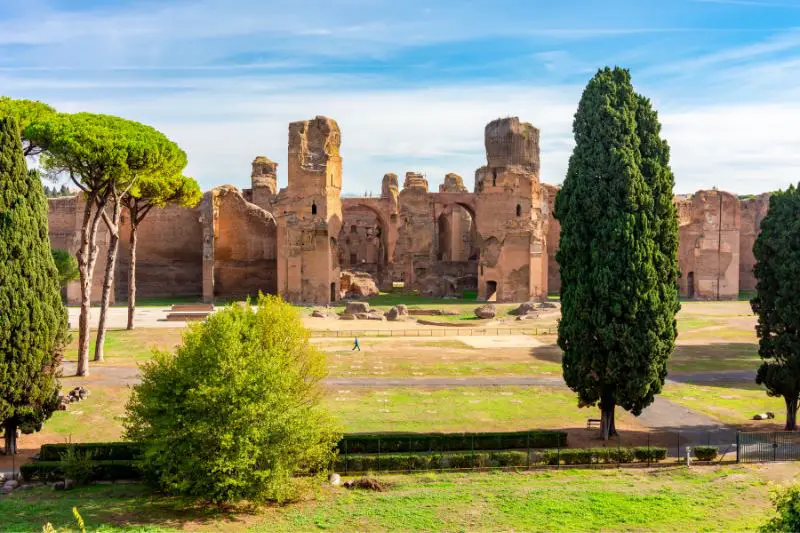
The Baths of Caracalla are an awe-inspiring testament to Roman engineering and luxury. Constructed in the 3rd century AD, these were more than just public baths; they were a center for leisure and socializing, offering libraries, gardens, and even a theater.
Today, visitors can wander through the colossal ruins of the bath complex, picturing the opulence that once filled these spaces. The sheer scale of the remaining walls and floors, along with detailed mosaics and stuccos, makes it easy to imagine the grandeur that the Baths of Caracalla once exhibited.
This historic site provides a quieter, more reflective experience than Rome’s more crowded attractions, allowing for an intimate appreciation of the ancient city’s splendor.
6. The Non-Catholic Cemetery
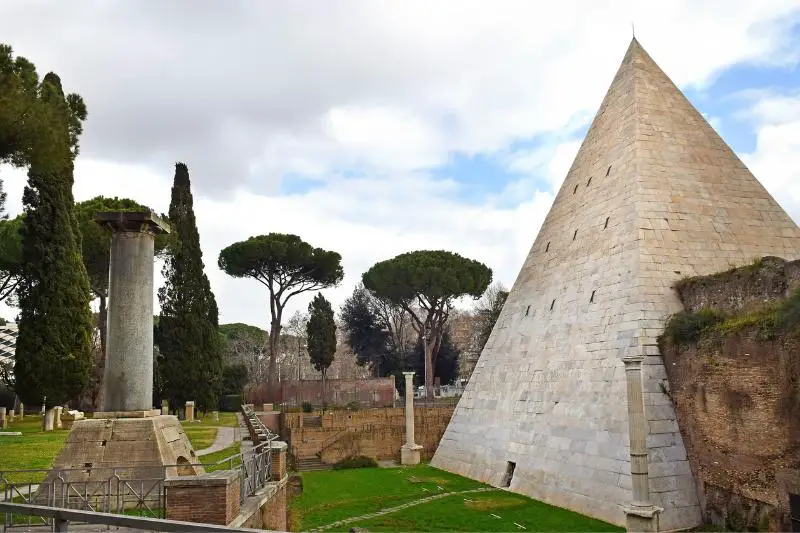
The Non-Catholic Cemetery for Foreigners in Testaccio, often referred to as the Protestant Cemetery, is a serene spot in Rome that offers a poignant look at the city’s cosmopolitan history. It is the final resting place of poets, artists, scholars, and diplomats, including the graves of John Keats and Percy Bysshe Shelley.
With its lovingly maintained graves, lush vegetation, and the charming resident cats, the cemetery feels more like a tranquil garden than a somber burial ground. It stands as a beautiful, reflective space, offering a quiet respite from the city’s hustle.
7. Quartiere Garbatella
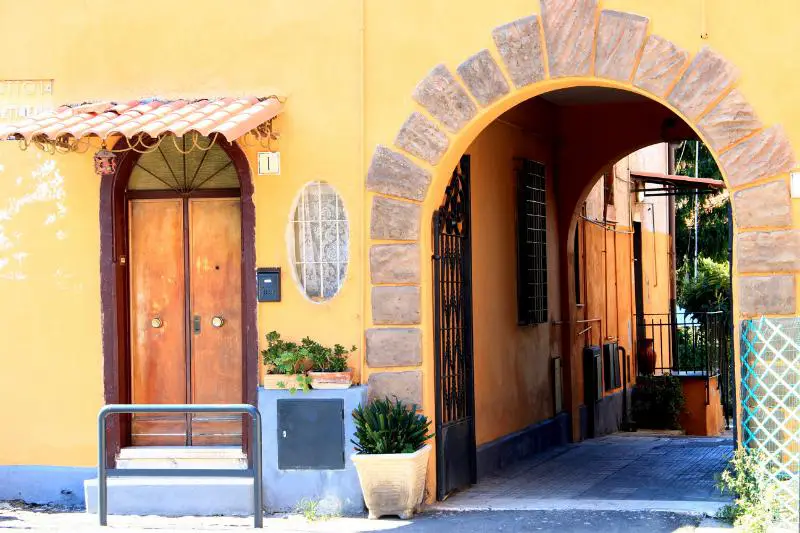
Quartiere Garbatella is Rome’s hidden village, boasting a labyrinth of courtyards, winding stairs, and colorful buildings adorned with greenery and ivy. Established in the 1920s, this neighborhood exudes a unique charm, characterized by its distinctive architectural style known as “Barocchetto Romano.”
Garbatella has a storied history of community and resistance, which today translates into a strong, vibrant local culture. Its lively piazzas, traditional trattorias, and local markets offer a genuine slice of Roman life.
Visiting Garbatella provides a refreshing glimpse into the daily rhythms and traditions of the city, away from the tourist centers—a truly authentic Roman experience.
8. Santa Prassede
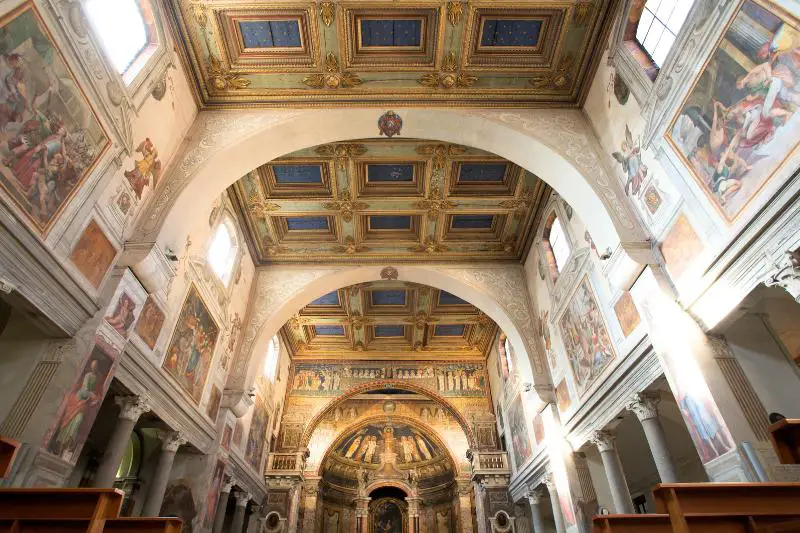
Santa Prassede is a small, unassuming church located just a short walk from the Basilica di Santa Maria Maggiore. Inside, it houses some of the most exquisite Byzantine mosaics in the Western world, including the stunning 9th-century Chapel of San Zeno.
These vibrant mosaics, with their gold backgrounds, depict scenes from the Old and New Testaments, alongside saints and martyrs, offering a dazzling display of medieval artistry.
Santa Prassede provides a quiet, contemplative experience, inviting visitors to linger and absorb the beauty and spiritual depth of these ancient works, away from the crowds of Rome’s larger basilicas.
9. Villa dei Quintili
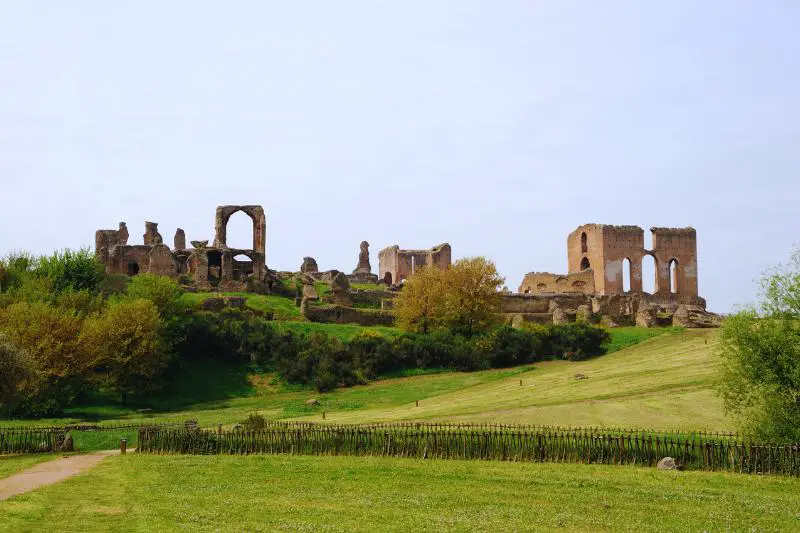
Villa dei Quintili was once a luxurious residence belonging to the Quintili brothers, who were consuls in 151 AD. The sprawling estate offers a glimpse into the opulent lifestyle of the Roman elite, with its extensive grounds, bath complexes, and athletic facilities.
Situated along the ancient Appian Way, the villa’s ruins provide a peaceful exploration site, surrounded by the Roman countryside’s natural beauty.
The sense of tranquility and the scale of the ruins inspire awe and provide a deeper connection to the daily lives of Rome’s ancient inhabitants, making it a must-visit for those looking to explore the city’s lesser-known historical sites.
10. The Knights of Malta Keyhole
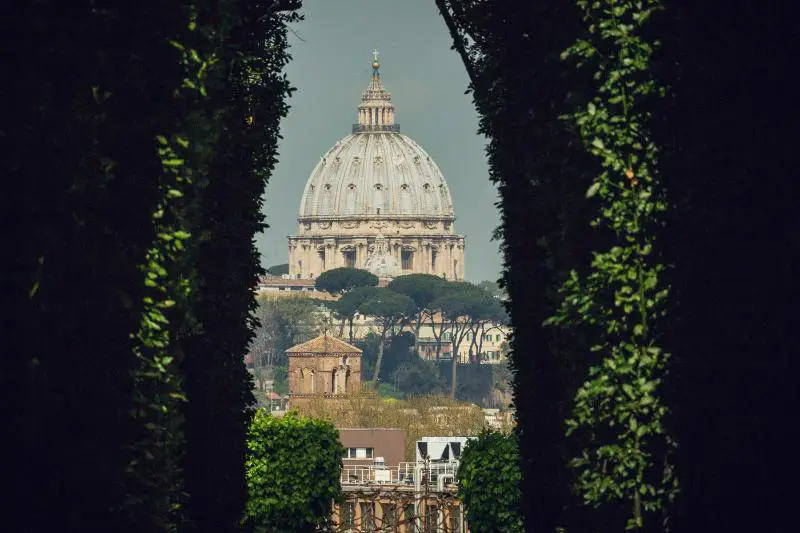
One of Rome’s most charming secrets is found at the Knights of Malta Keyhole on Aventine Hill. Looking through this unassuming keyhole, visitors are treated to a perfectly framed view of St. Peter’s Basilica in the distance, juxtaposed against the lush gardens leading up to the villa.
This singular, magical perspective encapsulates the beauty and mystery of Rome, a city layered in history and wonder. The site draws those in search of Rome’s hidden treasures, offering a moment of surprise and delight.
Rome’s allure extends far beyond the boundaries of its famous landmarks, revealing a city rich with hidden treasures for those willing to step off the beaten path. By visiting these lesser-known gems, travelers can uncover a more authentic Rome, one that whispers tales of its illustrious past and vibrant present through quiet piazzas, intimate cafes, and secluded gardens, free from the cacophony of mass tourism.
So, the next time you find yourself in Rome, dare to wander, to seek out the road less traveled, and in doing so, discover the city’s heart, pulsing quietly, invitingly, in the shadow of its monumental history yet in the bright light of its hidden wonders.
Learn more about the attractions in Central Italy with this guide to the best places to visit. You can also find all our travel guides to Central Italy here or enjoy our one week itinerary for Tuscany here. Don’t miss our guide to hidden gems in Venice here.
